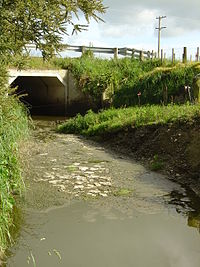
Photo from wikipedia
ABSTRACT The growth of swine production in Brazil has increased the amount of production and use of pig slurry (PS) as soil fertilizer. This product provides nutrients to plants, and… Click to show full abstract
ABSTRACT The growth of swine production in Brazil has increased the amount of production and use of pig slurry (PS) as soil fertilizer. This product provides nutrients to plants, and a continuous application of this residue usually increases total soil organic carbon (SOC) content. The objective of this study was to determine the SOC content and its distribution into humic substance fractions (humic acids, fulvic acids, and humin) in an Oxisol annually fertilized with PS for 15 years. The experiment was implemented in 2001 with a maize and oat crop rotation under no-tillage system in Campos Novos, SC, Brazil. The treatments used were: PS at rates of 0 (Control), 25, 50, 100, and 200 m3 ha-1 year-1, mineral fertilizer, and PS combined with mineral fertilizer, applied on the soil surface once a year. The 0-2.5, 2.5-5, 5-10, 10-20, 20-40, and 40-60 cm soil layers were evaluated for SOC content in the fractions humic acid, fulvic acid, and humin, and E4/E6 ratio of humic substances. Increases in PS rates up to 100 m3 ha-1 increased the SOC content in the 5-10 cm soil layer; however, decreased the proportion of the soil fulvic acid and humic acid fractions, favoring the accumulation of organic carbon in the humin fraction. The E4/E6 ratio was higher when using the soil mineral fertilizer than that found in treatments with PS.
Journal Title: Revista Brasileira de Engenharia Agricola e Ambiental
Year Published: 2021
Link to full text (if available)
Share on Social Media: Sign Up to like & get
recommendations!